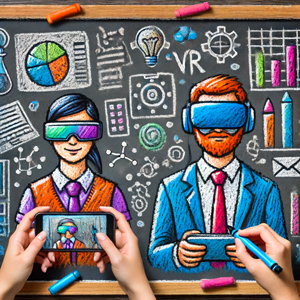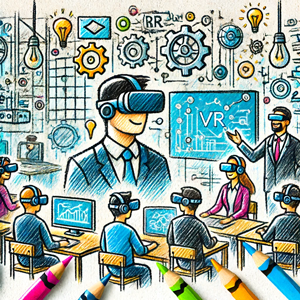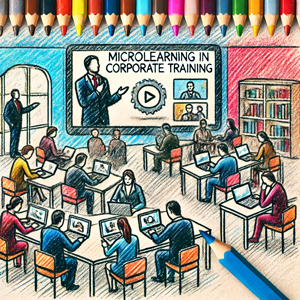Introduction
In continuing to explore corporate training innovations, this article focuses on the pioneering roles of augmented reality (AR) and virtual reality (VR) technologies.
Not merely enhancing the learning experience, AR and VR are revolutionizing it by providing immersive environments that closely simulate real-world scenarios. This update will delve into how these technologies are currently integrated into corporate training programs and the expanding advantages they offer.
Understanding AR and VR in Training

Before diving into their applications, it’s crucial to differentiate between AR and VR within the context of training:
- Augmented Reality (AR): AR enhances reality by overlaying digital information onto the real world, experienced through devices such as smartphones or AR glasses.
- Virtual Reality (VR): VR immerses users in a wholly digital environment that replaces the real world, typically accessed through VR headsets.
Applications of AR and VR in Corporate Training
AR and VR are leveraged across various sectors to address diverse training needs:
- Skill Development: VR is extensively used for training scenarios requiring hands-on experience, such as in surgical procedures, mechanical repairs, and public speaking.
- Safety Training: AR overlays safety protocols onto real-world machinery, guiding operators through processes in a controlled and safe manner.
- Soft Skills Enhancement: VR environments are ideal for practicing interpersonal skills, such as leadership and negotiation, because they provide lifelike scenarios without real-world consequences.
Technological Integration and Market Growth
Recent statistics highlight the rapid growth of AR and VR in the corporate training market, with significant increases in adoption rates and an expected rise in market value. These technologies are often integrated with other advanced systems, such as artificial intelligence, the Internet of Things, and cloud computing, enhancing the personalization and effectiveness of training modules.
Expanding Real-World Examples and Case Studies

A variety of industries have seen notable successes with AR and VR:
- A leading automotive manufacturer has reduced training time by 50% and errors by 30% using VR for assembly line workers.
- A global retail chain utilizes AR for onboarding new employees, overlaying store layouts with interactive information that accelerates the learning process for inventory management.
Advantages of Using AR and VR in Training
The integration of AR and VR into training programs offers several unique benefits:
- Engagement and Retention: The immersive nature of these technologies significantly enhances learner engagement and information retention.
- Risk Reduction: Training in virtual environments allows employees to practice hazardous procedures safely.
- Customizable Scenarios: AR and VR enable the creation of tailored scenarios that can be easily modified to meet changing organizational needs.
Addressing Challenges and Ethical Considerations
While transformative, the implementation of AR and VR technologies is not devoid of challenges:
- High Initial Costs and Technical Complexity: The upfront investment in AR and VR technology can be substantial, though costs decrease as the technologies become more widespread.
- Hardware Requirements: Accessing necessary hardware like AR glasses or VR headsets can be logistically challenging.
- Data Privacy and Ethics: With the increased use of these technologies, maintaining user privacy and securing sensitive data are paramount. Adhering to best practices for data security and ethical considerations is essential.
Conclusion

As AR and VR technologies evolve, their potential to enhance and transform corporate training grows exponentially. For trainers and HR professionals experienced in both traditional and digital training methods, exploring these advanced technologies offers a pathway to improve efficiency and engagement and fundamentally alter how knowledge and skills are imparted within organizations. The ongoing integration of these technologies into training programs is not merely a trend but a significant evolution in how corporate learning is approached.





